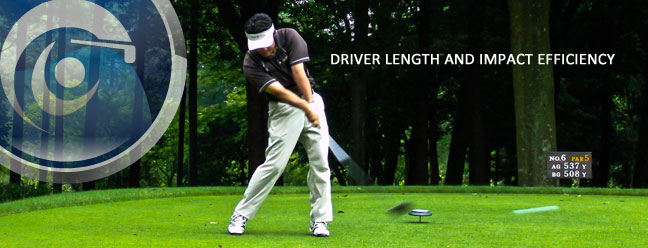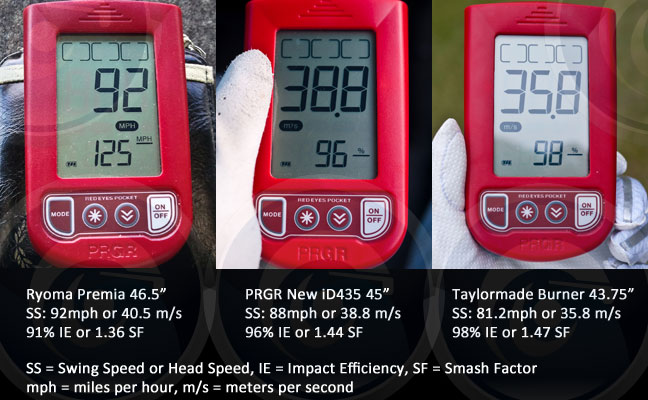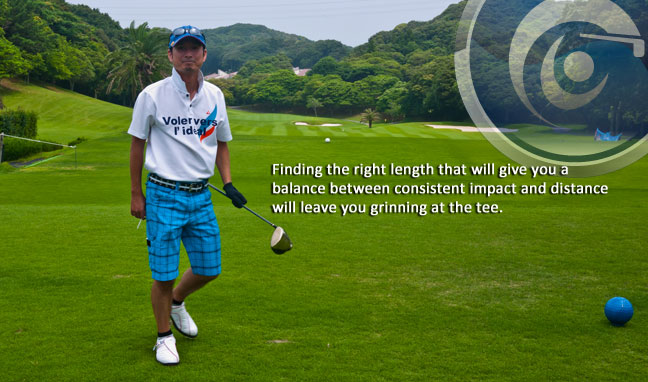One of common dilemmas when helping of fitting a customer for custom driver is what length they should get. Many customers simply say “I play standard length” or ask me to recommend what length is best for them. The problem is, like flex for golf shafts, there is no “standard” length for a driver. Every manufacturer offers different models with varying lengths from one another depending on what they think the target audience that club is intended for. Drivers today in their stock specs can range from 44.5″ to as long as 47″.
The key is get a driver with a length you are most comfortable with and most consistent with. The wrong length can equal lost distance, dispersion and poor impact, especially for many recreational and average golfers who have a hard enough time maintaining a consistent swing. There are many wonderful drivers out there today, packed with technology, the best materials and designs but no matter how great a driver is, its only good for you if you can strike its sweet spot. Many manufacturers boast nowadays how their longer length driver models increase swing speed and increase distance.
Today I’m going to take a look at driver length and how it “can” correspond with impact efficiency. In other words how does the length of a driver relate to how well you can hit the ball? Keep in mind that a comparison like this probably appeals much more to the average golfer and hacker on the course. Better players have more consistent swings, so length probably has less impact on performance or their ability to strike the sweet spot compared to us weekend golfers. Also keep in mind that this data is MY data, everyone is different. We all have different swing speeds, playing levels and swing styles. In the end these are just examples.
Since getting the PRGR Red Eyes Pocket, I have to say I’ve learned a lot more about my swing and have had a more interesting time testing clubs with it. It is always in my golf bag and even on the course during a round, everyone wants to try it which they can easily do since the REP stands alone as a speed monitor. I’ve always called myself an average golfer who sometimes dreads the driver. I’ve always guessed my swing speed to be around 90mph but after getting the REP I’ve been brought down to earth a bit and can confidently say that its more like 88mph on average. But as you will see from the examples I’ll put here, that swing speed will change depending on the length I am using. Please also note that this little experiment is NOT a driver comparison. I happen to be using 3 different drivers and am in no way trying to put them head to head for performance, but rather looking at their length vs impact.
So to get right to it, lets look at the 3 images above and review what the numbers mean. Please note the first image, as you can see, is in the MPH mode. I was at the driving range, and when I am typically alone, I use MPH mode, but on the course always m/s (meters per second) as my fellow Japanese golfers cannot relate to the MPH readings. Personally I am not very good with longer length drivers and its pretty evident in the first image. The 46.5″ Ryoma Premia increased my swing speed up to 92mph which is great but the ball speed and ultimately impact efficiency and smash factor were quite low at 91% and 1.36 meaning I was not squaring up to the sweet spot optimally or striking the ball very well for that matter.
In the second image, the PRGR driver is 45″ in length and this is actually right around where I like the driver length. So at 45″ I am hitting my ideal swing speed of 88mph and getting IE and SF of around 96% or 1.44 which is pretty respectable for an average golfer.
In the third image, I asked a lady golfer who I was playing with if I could tee off with her driver. She’s a pretty strong player so it was a Burner with an R2 (soft R) shaft at 43.75″ in length. I did not swing hard for fear of overpowering the driver and its evident as my swing speed dropped to 81.2mph or 35.2m/s but impact felt right on and the REP confirmed 98% IE and a smash factor of 1.47.
Its obvious that increasing length does increase swing speed but for me personally as the length gets longer my ability to square up and hit the sweet spot cleanly shrinks. This is probably something that could be improved on with practice but lets face it, we weekend and average golfers simply don’t practice enough, and thats probably why we are called average golfers in the first place. So what does that mean? Should I go for the shortest driver I can find in order to increase impact efficiency? At a certain point the law of diminishing returns comes into play and even as you strike the sweet spot better, a driver TOO short simply won’t generate enough ball speed and ultimately distance. So its finding the right balance of length and consistency which allows each individual to hit the ball on the center of the face and keep it straight in the fairway. For me its 45″ and around 96% or 1.44-1.45 smash factor. For you it might be 44″ or for the next person even 46″.
In the end length is just one of the factors affecting a club’s performance, finding the right club is more than just the length, but also the right flex, weight, trajectory, plus the right design to suit ones playing level. Doing your research and even experimenting goes a long way to improving your game. In the end we’re only as a good as our own swing allows us to be but having the right equipment sure makes the difficult game of golf more fun and all that little bit easier. If you need help, we’re always here to give advice.





This is simply fab-u-lous! Thank you Tario for your highly interesting stories here at GTI!
Help. I have the new PRGR Tester so how do I get it to the MPH mode?
Need a translation of the instructions.
Thanks.
Hi Doc, The link to the instructions is right in the product listing where you purchased the unit.
http://www.tourspecgolf.com/PRGR-Red-Eyes-Pocket-Multi-Speed-Tester
Its also in the forum.